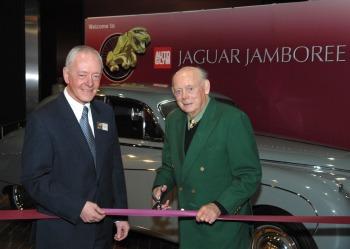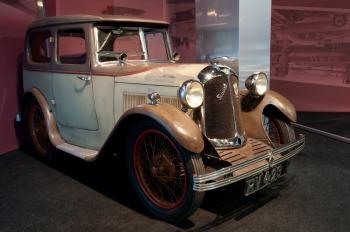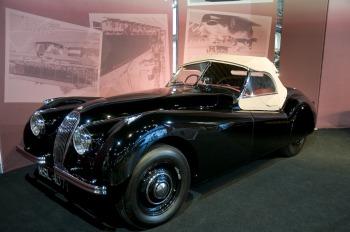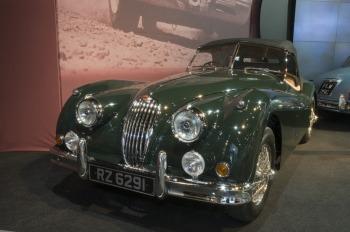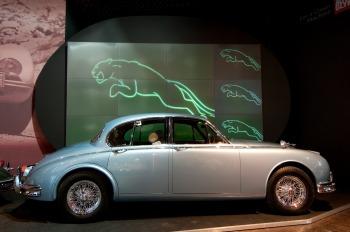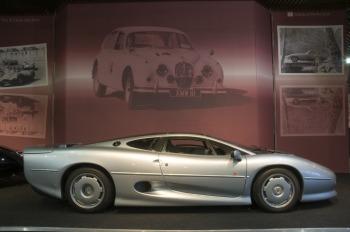|
Home | News | Road Tests | ||||
England's ‘Jaguar Jamboree’ Exhibition
England's National Motor Museum’s latest exhibition, ‘Jaguar Jamboree’, was unveiled on Thursday (26th March, 2009) by Lord Montagu. Few marques have generated such a rich heritage as that of Jaguar. As well as many iconic road cars, Jaguar can boast seven Le Mans 24 Hour victories, two World Sports Car Championships and countless rally successes. Originally a motor cycle sidecar manufacturer, the firm progressed into fabricating car bodies to fit standard production chassis. Eventually complete cars were built under the SS and, subsequently, Jaguar banners. Commandeered to manufacture parts and maintain military aircraft during World War II, a return to automobile production was made possible in 1945. The XK120, introduced in 1948, heralded a long line of classic sports cars and in the 1960s, Jaguar manufactured one of the world's most glamorous cars when the E-Type was unveiled. In recent times, Jaguar has experienced a take-over by American giants Ford who oversaw the introduction of the XK coupe and XF saloon. In 2008, Ford sold Jaguar to the Indian car manufacturer Tata. Lord Montagu said: “I am delighted to see such a fine collection of Jaguars at Beaulieu. I wrote the first ever biography of the marque way back in 1959 when I had the advantage of interviewing Sir William Lyons and hearing his comments about the early days of Jaguar direct from the founder, and have followed its fortunes ever since.” Beginning the story is the 1931 Austin Seven Swallow. It was made by the Swallow Sidecar Company, founded by William Lyons in 1922. The company progressed into making special bodied cars which eventually led to the Jaguar name making its first appearance. The post war period of the late 1940s and 1950s was a ‘golden age’ for Jaguar, beginning with the Jaguar XK120 which caused a sensation when it was unveiled at the first post-war London Motor Show in 1948. Beautifully designed with an advanced and powerful new 6 cylinder XK engine, it promised high performance and with a factory price of just £988, was undoubtedly the highlight of the show. The 1950 example on display was originally supplied to a dealer in Geneva, Switzerland before eventually returning to Britain and restored to concours standard. Also on display from this ‘golden age’ is a 1954 Jaguar XK140 Open Two Seater, with chassis Number 2 – the oldest right-hand drive roadster in existence. The 1959 Jaguar Mark lX, is outwardly identical to its predecessor, the Mark Vll which, when unveiled at the 1950 Earls Court Motor Show, was regarded as a triumph of motoring design. Performance was better than any other large saloon of the time with a top speed of 100 mph. It also proved its worth on the race track with a number of victories in production car racing. The year 2009 marked the 50th anniversary of the Jaguar Mk2, a car that found favour in all areas of society, gaining notoriety with criminal gangs as a large and fast getaway vehicle, or as a very capable police patrol car, especially on British motorways. Between 1959 and 1967, 100,000 Mk2s were sold making it the most successful Jaguar, before the introduction of the XJ6 in 1968. On display is a Jaguar XJ6 engine, described by Motor magazine as, “Probably the most famous engine ever produced by the British motor industry.” The XJ6 overtook the Mk2 as the most successfully selling Jaguar of all time and, today, is still in production, albeit in an updated form. In 1992, the Jaguar XJ220, the first new road-going Jaguar sports car to appear in 27 years, was the world’s most expensive production car and Jaguar’s fastest ever road car. A ‘Saturday Club’ of company volunteers worked in their own time to develop and build it on a shoestring, with more than 40 companies contributing components. Only 280 were built. Bringing the Jaguar story right up to date is a 2007 Jaguar XF SV8, the very first example of the XF off the production line. It was gifted to the Jaguar Daimler Heritage Trust museum collection straight from the factory. The XF closely followed the design set by the C-XF concept car unveiled at the Detroit Motor Show in January 2007. With the C-XF, Jaguar had announced a completely new direction for future designs and the concept car received tremendous praise for its modern and distinctive styling. Accompanying the exhibition, a video wall presentation features exquisite footage, set to music, depicting the proud history of this illustrious company through its cars. The ‘Jaguar Jamboree’ exhibition which runs until March 2010, can be seen as part of a visit to the whole Beaulieu attraction. On 19th July 2009, in celebration of the exhibition, there will be a Jaguar Jamboree Day at Beaulieu, giving Jaguar car owners the opportunity to be part of the collection for the day. | ||||
More Jaguar News .....
here
About | Car Clubs | Home | News | Road Ramblings | Road Tests | Subscribe | Top Drive © 2009 All rights reserved. Next Car Pty. Ltd. |

